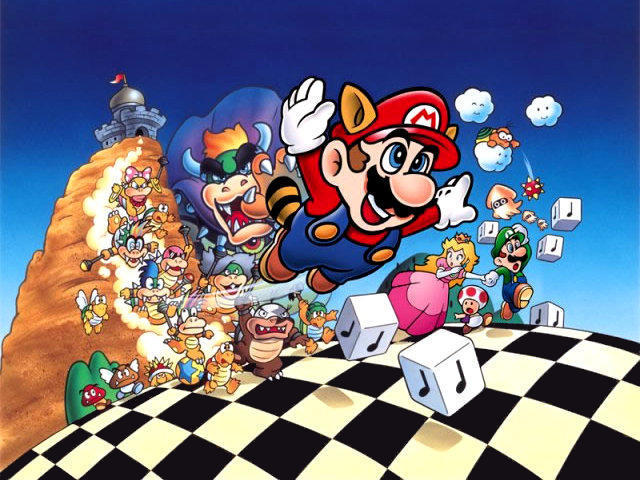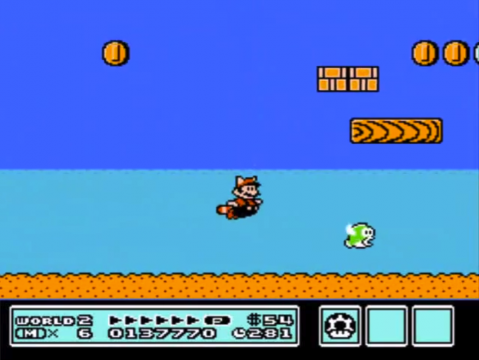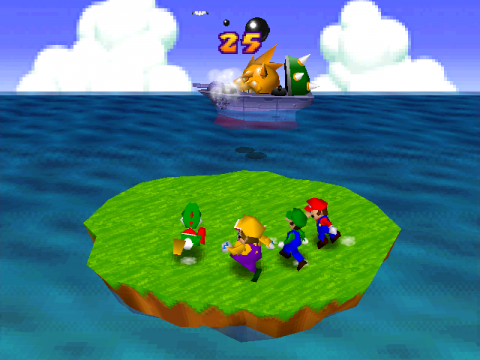
|
Over the course of his thirty-plus year career, Mario has managed to avoid doing much plumbing. He’s known as a golfer, racing driver, doctor, and hero of the land– but which of these callings has been the most enjoyable will always remain a source of contentious debate.
For instance, the Super Mario Kart series has been going on for two decades and has sold strongly since its conception. Though it’s since dropped the “Super” prefix, it remains a fan favourite and its roster of characters and range of items have ensured that everyone from the most casual to the most devoted of Mario fans still regularly picks them up. The games have the added advantage of being excellent in multiplayer, whether at a rather raucous party or, more recently, online. While they’re fairly easy and have their share of broken elements (the blue shells remaining a thorn in many sides) they remain popular and high quality.
Or maybe the originals are the best. The games that launched the Mario series to the heights of popularity– specifically Super Mario Bros., Super Mario Bros. 3, and Super Mario World. While their gameplay might be quite primitive by modern standards, their commitment to excellent platformer design and knock-on effect on game design for decades is undeniable. The appeal of the 2D platformers was that they balanced simple mechanics with challenges that were difficult, but not insurmountable. It gave players enough free rein to keep going, but didn’t give everything away at once.

Instead, you may find your favourite Mario games among the 3D offerings. While they might not have the retro cachet of the NES and SNES titles, they’ve introduced innovative mechanics like the hubs of Peach’s Castle and Delfino Plaza, FLUDD, and the wonderful gravity puzzles of the Galaxy games. Moreover, they’ve driven sales of Nintendo consoles even in the uncertain days of the Nintendo 64 and GameCube. While neither of those machines sold tremendously well, it may well have been Mario’s early polygonal outings which kept their heads above water.
The first venture into the unfamiliar territory of a story based Mario game came courtesy of Squaresoft in the mid-nineties, with the release of Super Mario RPG for SNES. Even if European gamers had to wait a decade and a half to play it, it ushered in the reputation, well-deserved, that the Mario RPGs have for an accessible but biting humour. Spiritually, Super Mario RPG found its sequel in 2000’s Paper Mario. Deliberately lacking in the graphical department, the Paper Mario series ended up carving out a niche of its own and the four games remain fan favourites. They combine the trademark humour with excellent world building, a wide variety of sidequests, and characters, and plots that invariably boil down to much more than “save the Princess.” Though sales of those games were never stellar, they balanced gameplay, plot, and presentation in a perfect fashion. They showed that RPGs could break the mold of serious questing, poked fun and well-worn gaming tropes, and gave personality to Mario that he lacked for over a decade.
The Mario Party series has been running for years, and has been the bane of many of those who’ve gone into it wanting a collection of minigames to play through lightly of an evening with friends. When said friends leaving with Wii Remote wounds and a profound hatred for slow dice-rolling mechanics, it becomes plain that the series is not without issues. Mario Party’s problem is that the format doesn’t leave enough room for sequels, but that Nintendo bloody-mindedly insists on putting them out anyway, and there’s only so many times you’ll pay for pretty much the same thing.

The final series, four games released over the course of a decade and largely forgotten except by long-time Nintendo fans, is Mario & Luigi. The RPG direction taken here retained the humour and irreverent nature of Paper Mario, but featured rather more puzzle solving elements. It also gave us the neighbouring nation of the Beanbean Kingdom, ruled by strange green people with their own monarchy and diplomatic relations with the Mushroom Kingdom. The Mario & Luigi series may be relatively unknown, but it built on the personalities of many characters, particularly Bowser and Luigi, by giving them voices or gameplay segments of their own. One particularly memorable sequence involves helping a trembling Luigi traverse a dungeon and temporarily being fooled into thinking he’s Mario, so that for once in his life he’ll act brave.
Awarding the accolade for the greatest of Mario’s sub-series will always be a difficult task, and not just because the variety of series means that direct comparison struggles. It is a result of the mostly high-quality amongst the games and that they all try to achieve different things. That said, it would be difficult to deny that the Paper Mario games (and their spiritual prequel Super Mario RPG) have provided the most consistent quality, depth and individuality. They are an example of what Nintendo can do well when it tries its best, and should be applauded.
What about you? Which Mario series do you think is best? Share your thoughts with us in the comments!




 ShareThis
ShareThis







